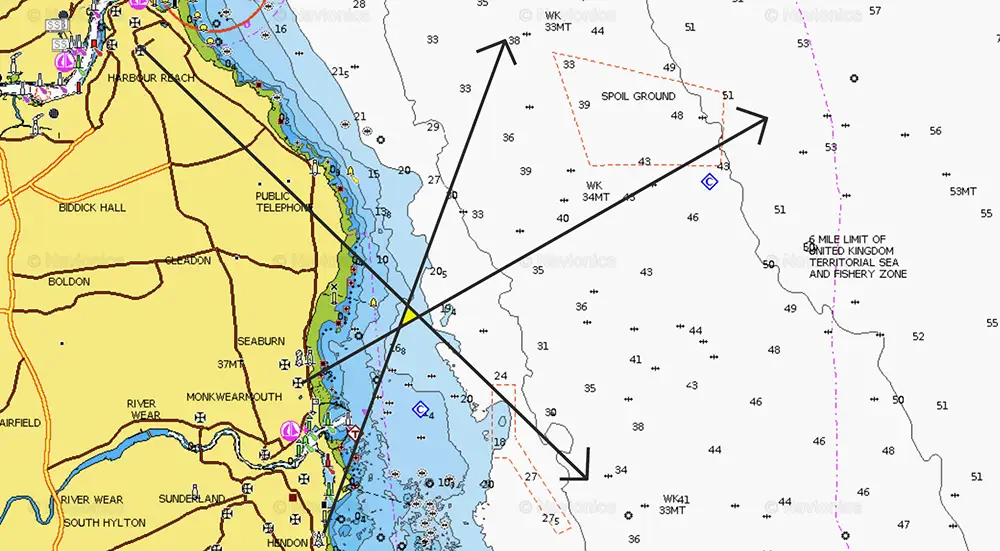As a yacht skipper, your responsibility is to navigate your vessel safely and efficiently. While electronic devices such as GPS have revolutionized navigation, becoming overly reliant on them can not just lose much of the fun of navigating out on the water, but can be a recipe for disaster. Electronic devices can lose signal, run out of battery and can suddenly be 10-20 metres out of position. They also don’t encourage the all-important situational awareness. This is why the timeless skill of taking and plotting visual fixes to determine your position remains as crucial as ever – and a legal requirement for commercial sailors. A visual fix involves taking compass bearings off charted landmarks to determine your vessel’s position. It’s a fundamental skill, covered in both the RYA Day Skipper and RYA Yachtmaster syllabus, that builds confidence in where you are and ensures you can navigate safely even when technology fails.
Gear Up: Tools for the Trade
To take a visual fix, ensure you have the necessary tools:
- Chart: A large-scale chart of your intended sailing area is essential. Look for one with clear details like prominent landmarks, navigational aids (lights, buoys), and depth contours.
- Parallel Ruler or Portland Plotter: An essential tool that allows you to draw accurate lines on your chart.
- Dividers: These are used to measure distances on the chart.
- Hand Bearing Compass: A hand-held compass is needed to take bearings of landmarks. A high quality one will be much easier to use than a cheap one. High-end binoculars can also have an in-built compass, providing superb capabilities to take precise bearings.
- Watch: You’ll need this to record the exact time of your observations.
The Art of Taking a Visual Fix:
Here’s a step-by-step guide to taking a visual fix using a compass:
- Identify Landmarks: Look for prominent, easily identifiable landmarks on the chart, such as lighthouses, church spires, or distinctive rocks. Make sure you have not misidentified the object, which is easily done. Avoid using land masses or cliff faces, as these are notoriously difficult to obtain an accurate bearing.
- Take Bearings: Using your compass, carefully sight each chosen landmark. Align the lubber line with the landmark and note the bearing. Record the bearing and the time of the observation and the vessel’s log. You will need a minimum of two objects and preferably three. if you can only see one object, then you will have to make a running fix.
- Plot the Line of Position (LOP): On your chart, locate each landmark you used. Using your parallel ruler or plotter, and the bearing you recorded, draw a line on the chart that extends outwards from the landmark at the angle of the bearing. Draw an arrow on the end of the line to show it is a bearing.
Note: Each LOP represents a line on which your vessel sits at the time of taking the bearing. You will not know where you are on that line until you take a second bearing.
- The Fix: The point where the two or more LOPs intersect is your position. With three accurate bearings, the intersection will be a small triangle, indicating a high degree of accuracy.

Putting it All Together: Tips for Success
- Practice Makes Perfect: Before you need to take a fix in anger, practice taking visual fixes in familiar waters. This builds confidence and familiarity with the process.
- Accuracy is Key: Take your time to be precise. Even a slight mistake will affect the accuracy of your fix.
- Favour Reliable Landmarks: Choose landmarks that are fixed, prominent, and easy to identify on your chart. Avoid where possible using features that might change, like buoys that can be moved or lights that could be malfunctioning.
- The More the Merrier: Take bearings of at least two, preferably three, landmarks for a more accurate fix. With more LOPs, any errors in individual bearings are minimized.
- Cross-check with Electronics (when available): If your GPS is still functioning, compare your visual fix with the electronic position. This helps identify any discrepancies and reinforces your confidence in your visual fix skills.
- Plot Regularly: Don’t wait until you’re unsure of your position. Make it a habit to take and plot visual fixes regularly throughout your voyage. This allows you to constantly monitor your progress and identify any potential navigational errors early on. It is much easier to track your positions than find your position.
Want to learn more?
These are the skills you will learn on a Rubicon 3 adventure. The instructors will not only teach you how to take a bearing but will encourage you to use the skill throughout your time on board. Join a trip to mix superb sailing, high adventure and top quality training. Find your big adventure here!